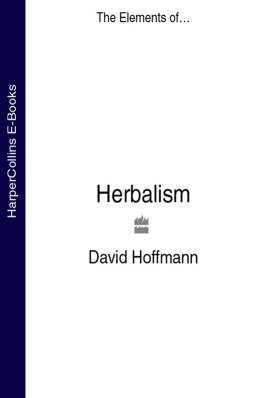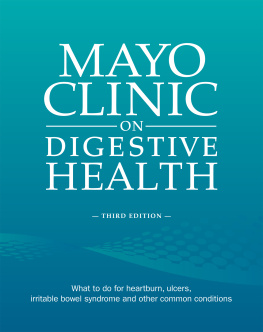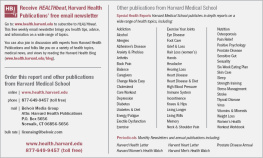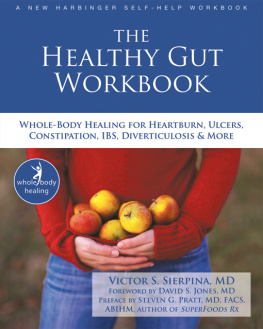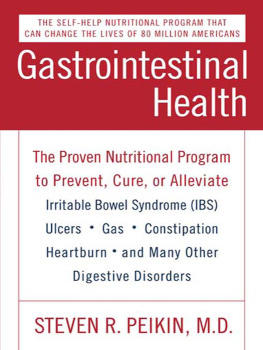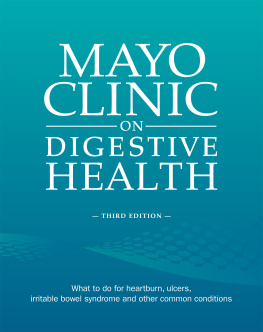Contents
Dedication
Thank you Lolo you know why!
This book is also dedicated to all my brothers and sisters who grew up experiencing the dubious joys of English cooking. Yes, there is life beyond the chip butty...
Chapter 1
Understanding the Digestive System
Herbal medicine is uniquely suited for the treatment of illness of the digestive system. Throughout the natural world food is medicine, and the same concept applies to herbs the ultimate medicinal food.
Much of the digestive system illness in our society is simply due to abuse. Todays average Western diet includes a preponderance of overly processed foods, a high proportion of chemical additives, and the direct chemical irritation of alcohol, carbonated drinks, and tobacco. In this context it is easy to see why herbal remedies are so helpful in healing digestive problems; the soothing of demulcents, healing of astringents, and general toning of bitters do much to reverse the damage we do every day.
What Is the Digestive System?
The digestive system is a series of hollow organs joined in a long, twisting tube known as the alimentary canal from the mouth to the anus. Inside the tube is a lining called the mucosa, which in the mouth, stomach, and small intestine contains glands that produce digestive juices. The liver and the pancreas are also part of the system, producing juices that reach the intestine through small tubes.
The Digestive System

The Process of Digestion
The food we eat is not in a form that the body can use as nourishment. It must be broken down into smaller molecules of nutrients that the blood can absorb and carry to the cells of the body. Digestion breaks down food and drink into their smallest parts so that the body can use them to build and nourish cells and to provide energy. The process, which begins in the mouth with chewing and swallowing and is completed in the small intestine, involves the mixing of food, its movement through the digestive tract, and the chemical breakdown of its large molecules into smaller molecules. The chemical process varies somewhat for different kinds of food.
The digestive systems hollow organs contain muscles that enable their walls to move. This involuntary movement, called peristalsis, not only forces the contents forward but also mixes them. When we swallow, peristalsis begins. The muscles then contract and narrow, propelling the food particles and fluid down the length of the alimentary canal in slow waves.
The esophagus connects the throat above with the stomach below. At the junction of the esophagus and stomach, a ringlike valve closes the passage between the two organs. As the food travels down the esophagus and approaches the closed ring, the surrounding muscles relax and allow the food to pass through.
The food then enters the stomach, which performs several functions. The stomach stores the swallowed food and liquid and produces digestive juices. Muscle action in the lower part of the stomach mixes the contents of the stomach. Finally, the stomach slowly empties its contents into the small intestine. Several factors affect this emptying, including the nature of the food and the degree of muscle action of the emptying stomach and the small intestine. As the food is digested in the small intestine and dissolved by the juices from the pancreas, liver, and intestine, muscle action continues to mix the contents of the intestine and push them forward.
Finally, all of the digested nutrients are absorbed though the intestinal walls. The waste products of this process include undigested parts of the food, known as fiber, and older cells that have been shed from the mucosa. These materials are propelled into the colon, where they remain, usually for a day or two, until they are expelled as feces through a bowel movement.
The production of digestive juices is a vital function of the digestive system. The salivary glands in the mouth start that process. An enzyme in saliva begins to digest the starch in food into smaller molecules. The next set of glands involved in digestion is in the lining of the stomach. These gastric glands produce stomach acid and an enzyme that digests protein. One of the unsolved puzzles of the digestive system is why the acid juice of the stomach does not dissolve the tissue of the stomach itself.
After the stomach empties the food and its juice into the small intestine, the juices of two other digestive organs, the pancreas and the liver, mix with the food to continue the digestion process. The pancreas produces an array of enzymes that break down carbohydrates, fat, and protein in food. Other enzymes involved at this stage of the process come from glands in the wall of the small intestine.
The liver produces bile, which is stored in the gallbladder until needed. At mealtime, the bile is squeezed out of the gallbladder through the bile ducts and into the intestine and mixes with the fat in our food. The bile acids dissolve the fat into the watery contents of the intestine, acting much like detergents that dissolve grease in water. Enzymes from the pancreas and the lining of the intestine digest the dissolved fat.
Why Use Herbs?
Herbs unique healing properties have a direct effect upon the lining of the alimentary canal. The herbs constituents can directly touch the cells of the mucosa without first having to be assimilated into the bloodstream, travel through the liver, and make their way through the rest of the body before entering the cells from the blood. Thus, the body can rapidly reap the benefits of constituents that might reduce inflammation, relax muscles, combat bacterial infection, or promote the healing of wounds.
However, as with all true healing, any potential cure lies beyond the range of medicines, be they herbal or pharmaceutical. The healing process must involve a lifestyle change that includes a healthy diet and reduction of tress. Herbal medicine can bring about dramatic improvements in even profound digestive system problems, but you wont experience its full benefits unless you also follow a healthy lifestyle. The long-term maintenance of the benefits you get from herbs lies in your hands alone.
What Herbs Do
Europeans have long used herbs to aid digestion. From culinary herbs such as rosemary to medicinal alcohols such as vermouth or Chartreuse, Europeans use these remedies in large quantities. The very name vermouth is derived from the bitter remedy wormwood, whose name in German is wermut. In official pharmacopoeias, such as the U.S. Pharmacopoeia (USP) and British Pharmacopoeia (BP), herbs have the strongest foothold as therapeutic agents in the categories o digestive bitters, carminatives, and laxatives of varying strengths.
In the hands of a skilled herbalist, much can be achieved therapeutically. While each individual with a gastric ulcer, for example, will have his or her own set of unique causes, we can identify a treatment based on our knowledge of the different herbs.
Used holistically, herbal medicine offers specific remedies for particular pathological syndromes as well as preventive tonics and normalizers. Treating the problem within this context of general nurturing speeds improvement and reestablishes health and harmony.





